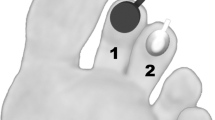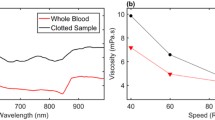Abstract
The aim of this study was to validate a non-invasive optical probe for simultaneous blood flow measurement at different vascular depths combining three photoplethysmography (PPG) channels and laser Doppler flowmeter (LDF). Wavelengths of the PPG were near-infrared 810 nm with source-to-detector separation of 10 and 25 mm, and green 560 nm with source-to-detector separation of 4 mm. The probe is intended for clinical studies of pressure ulcer aetiology. The probe was placed over the trapezius muscle, and depths from the skin to the trapezius muscle were measured using ultrasound and varied between 3.8 and 23 mm in the 11 subjects included. A provocation procedure inducing a local enhancement of blood flow in the trapezius muscle was used. Blood flows at rest and post-exercise were compared. It can be concluded that this probe is useful as a tool for discriminating between blood flows at different vascular tissue depths. The vascular depths reached for the different channels in this study were at least 23 mm for the near-infrared PPG channel (source-to-detector separation 25 mm), 10–15 mm for the near-infrared PPG channel (separation 10 mm), and shallower than 4 mm for both the green PPG channel (separation 4 mm) and LDF.




Similar content being viewed by others
References
Allen J (2002) The measurement and analysis of multi-site photoplethysmographic pulse waveforms in health and arterial disease. PhD thesis, Newcastle University, Newcastle, UK
Bangsbo J, Hellsten Y (1998) Muscle blood flow and oxygen uptake in recovery from exercise. Acta Physiol Scand 162:305–312. doi:10.1046/j.1365-201X.1998.0331e.x
Bergstrand S, Lindberg LG, Ek A-C, Lindén M, Lindgren M (2009) Blood flow measurements at different depths using photoplethysmography and laser Doppler techniques. Skin Res Technol 15:139–147. doi:10.1111/j.1600-0846.2008.00337.x
Bouten Carlijn V, Oomens Cees W, Baaijens Frank P, Bader Daniel L (2003) The etiology of pressure ulcers: skin deep or muscle bound? Arch Phys Med Rehabil 84:616–619. doi:10.1053/apmr.2003.50038
Bridel J (1993) The aetiology of pressure sores. J. Wound Care 2:230–238
Cai W, Schaper W (2008) Mechanisms of arteriogenesis. Acta Biophys Sin 40:681–692. doi:10.1111/j.1745-7270.2008.00436.x
Clark M, Rowland LB, Wood HA, Crow RA (1989) Measurement of soft tissue thickness over the sacrum of elderly hospital patients using B-mode ultrasound. J Biomed Eng 11(3):200–202
Daniel RK, Priest DL, Wheatley DC (1981) Etiologic factors in pressure sores: an experimental model. Arch Phys Med Rehabil 62:492–498
Ek AC, Gustavsson G, Lewis DH (1987) Skin blood flow in relation to external pressure and temperature in the supine position on a standard hospital mattress. Scand J Rehab Med 19:121–126
Gailite L, Spigulis J, Lihachev A (2008) Multilaser photoplethysmography technique. Lasers Med Sci 23:189–193. doi:10.1007/s10103-007-0471-9
Gan KB, Zahedi E, Mohd Ali MA (2009) Transabdominal fetal heart rate detection using NIR photopleythysmography: instrumentation and clinical results. IEEE Trans Biomed Eng 56(8):2075–2082
Hodges GJ, Jackson DN, Mattar L, Johnson JM, Shoemaker JK (2009) Neuropeptide Y and neurovascular control in skeletal muscle and skin. Am J Physiol Regul Integr Comp Physiol 297(3):546–555
Jakobsson A, Nilsson GE (1993) Prediction of sampling depth and photon pathlength in laser Doppler flowmetry. Med Biol Eng Comput 31(3):301–307. doi:10.1007/BF02458050
Jonsson A, Lindén M, Lindgren M, Malmqvist LA, Bäcklund Y (2005) Evaluation of antidecubitus mattresses. Med Biol Eng Comput 43(5):541–547. doi:10.1007/BF02351025
Kosiak M (1959) Etiology and pathology of ischemic ulcers. Arch Phys Med Rehabil 40:62–69
Lamby P, Prantl L, Gais S, Walter M, Bachthaler M, Nerlich M, Feuerbach S, Jung EM (2008) Evaluation of the vascular integrity of free flaps based on microcirculation imaging techniques. Clin Hemorheol Microcirc 39(1–4):253–263. doi:10.3233/CH-2008-1094
Liebert A, Leahy M, Maniewski R (1998) Multichannel laser-Doppler probe for blood perfusion measurement with depth discrimination. Med Biol Eng Comput 36:740–747. doi:10.1007/BF02518878
Lindberg LG, Öberg PÅ (1991) Photoplethysmography: Part 2. Influence of light source wavelength. Med Biol Eng Comput 29:48–54. doi:10.1007/BF02446295
Linder-Ganz E, Shabshin N, Itzchak Y, Yizhar Z, Siev-New I, Gefen A (2007) Strains and stresses in sub-dermal tissues of the buttocks are greater in paraplegics than in healthy during sitting. J Biomech 41:267–580
Lindgren M, Malmqvist L-Å, Sjöberg F, Ek A-C (2006) Altered skin blood perfusion in areas with non blanchable erythema: an explorative study. Int Wound J 3:215–223. doi:10.1111/j.1742-481X.2006.00238.x
Monstrey S, Hoeksema H, Verbelen J, Pirayesh A, Blondeel P (2008) Assessment of burn depth and burn wound healing potential. Burns 34(6):761–769
Nilsson GE, Tenland T, Öberg PÅ (1980) A new instrument for continuous measurement of tissue blood flow by light beating spectroscopy. IEEE Trans Biomed Eng 27(1):12–19a
Nilsson GE, Tenland T, Öberg PÅ (1980) Evaluation of a laser Doppler flowmeter for measurement of tissue blood flow. IEEE Trans Biomed Eng 27(10):597–604b
Nilsson GE, Salerud EG, Strömberg NOT, Wårdell K (2003) Laser Doppler perfusion monitoring and imaging. In: Tuan V-D (ed) Biomedical photonics handbook. CRC Press, Boca Raton
Näslund J, Pettersson J, Lundeberg T, Linnarsson D, Lindberg LG (2006) Non-invasive continuous estimation of blood flow changes in human patellar bone. Med Biol Eng Comput 44(6):501–509
Sandberg M, Zhang Q, Styf J, Gerdle B, Lindberg LG (2005) Non-invasive monitoring of muscle blood perfusion by photoplethysmography: evaluation of a new application. Acta Physiol Scand 183:335–343. doi:10.1111/j.1365-201X.2005.01412.x
Sandberg ML, Sandberg MK, Dahl J (2007) Blood flow changes in the trapezius muscle and overlying skin following transcutaneous electrical nerve stimulation. Phys Ther 87(8):1047–1055
Stekelenburg A, Gawlitta D, Bader Dan L, Oomens Cees W (2008) Deep tissue injury: how deep is our understanding? Arch Phys Med Rehabil 89:1410–1413. doi:10.1016/j.apmr.2008.01.012
Thrani H, Moncrieff M, Philip B, Dziewulski P (2008) Spectrophotometric intracutaneous analysis: a novel imaging technique in the assessment of acute burn depth. Ann Plast Surg 61(4):437–440
Tulevski I, Ubbink D, Jacobs M (1999) Red and green laser Doppler compared with capillary microscopy to assess skin microcirculation in the feet of healthy subjects. Microvasc Res 58:83–88. doi:10.1006/mvre.1999.2159
Witkowski JA, Parish LC (1982) Histopathology of the decubitus ulcer. J Am Acad Dermatol 6:1014–1021
Zhang Q, Lindberg LG, Kadefors R, Styf J (2001) A non-invasive measure of changes in blood flow in the human anterior tibial muscle. Eur J Appl Physiol 84(5):448–452
Zourabian A, Siegel A, Chance B, Ramanujan N, Rode M, Boas DA (2000) Trans-abdominal monitoring of fetal arterial blood oxygenation using pulse oximetry. J Biomed Opt 5(4):391–405
Author information
Authors and Affiliations
Corresponding author
Rights and permissions
About this article
Cite this article
Hagblad, J., Lindberg, LG., Kaisdotter Andersson, A. et al. A technique based on laser Doppler flowmetry and photoplethysmography for simultaneously monitoring blood flow at different tissue depths. Med Biol Eng Comput 48, 415–422 (2010). https://doi.org/10.1007/s11517-010-0577-2
Received:
Accepted:
Published:
Issue Date:
DOI: https://doi.org/10.1007/s11517-010-0577-2




